There are spinning lures, you can’t but fall in love with, if you happen to get them. These are often “handmade” lures, designed with love and understanding of what (whom) they are intended for. Without any doubt, Spanish “Lurenzo Lures” are lures of such a kind. They are both aesthetically pleasing and efficient. adriaticnature simply had to talk to their creator Isaac Lorenzo from Badalona, Spain.

(Isaac with a bluefin tuna caught with “Espetit”. Photo © Lurenzo)
– Hello, Isaac! Thanks for taking the time to talk to us. Your lures are well known to many anglers all over the world, but more fans of spinning fishing, passionate about catching predatory fish, should definitely know about them. Tell us, please, a little about yourself. When and why did you start making your own lures?
Hello! Thanks for providing me with the opportunity to help anglers get acquainted with me.
At first, making lures was my hobby. When I was a kid, I used to like racing toy cars, model-car construction, radio-controlled car models, and set them up for racing myself. But I’m a fisherman, and once, in 2005, I tried to make my own jigs and other lures for “light jigging”. And they appeared to be rather efficient. In 2007, I began to make plugs and topwater lures for myself. At that time, I adored this method of fishing, and catching the European seabasses was my favorite activity.

(European seabass caught with “Espetit”. Photo © Lurenzo)
– Lurenzo Don Belone and Lurenzo Espetrón are your most famous lures. Let’s talk about them a little bit. Don Belone is a sinking topwater lure imitating a garfish. Lures of such a shape have become extremely popular for the last two or three years. What features does Don Belone have? What makes it different from other lures? What fish species, apart from bluefish, which likes your “garfish” so much, attack this plug? What are the main ways to animate it?
Most anglers know that garfish is one of the best lures they can offer to sea predators. They never stay indifferent to a small barracuda as well.
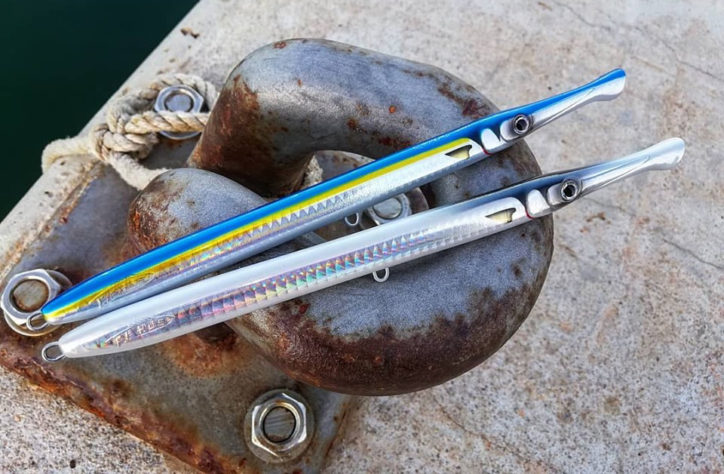
(“Don Belone” lures. Photo © Lurenzo)
In 2009, I started thinking about the lures I needed. I was keen on catching bluefishes and leerfishes. Fishermen tried to catch these predators with the help of “drifting”, using dead fish as a buzz, but I wanted to catch leerfishes and bluefishes with a spinning rod. So, I decided to make lures, similar to garfish and barracuda. I kept on experimenting with their shape and other design features. That was the time, when Don Belone and Lurenzo Espetrón occurred. Perhaps, if I had seen something like that on sale, I wouldn’t have tried to invent anything. But since there were no such lures on the fishing tackle market, I made them myself.
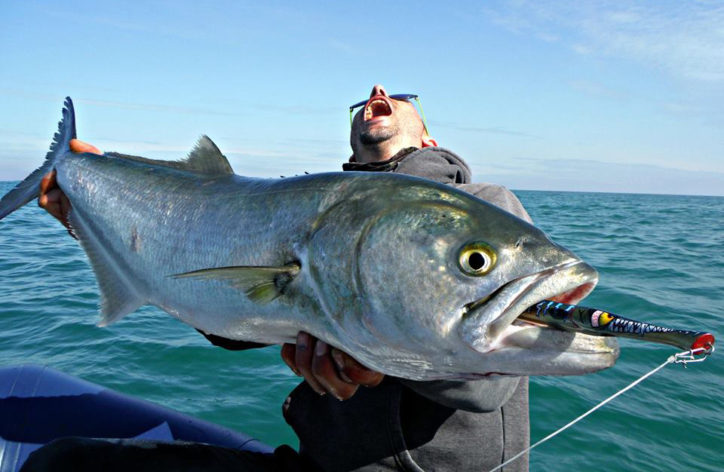
(Bluefish caught with “Don Belone”. Photo © Lurenzo)
Belone is an outstanding lure. It helps you find fish at the depth you need. You can retrieve both slowly and quickly, depending on what you think at the moment about the mood of the predators. And it starts working. Especially when the fish don’t want to attack other lures, you cast Don Belone and you feel the difference!
What fish species attack the lure? Leerfishes, bluefishes, truly large European seabasses, amberjacks, bluefin tunas, barracudas, mahi-mahis, little tunnies, bonitos, jacks, swordfishes, needlefishes, triggerfishes and so on. Belone is sometimes attacked by squids, cuttlefishes and octopuses. You must trust the lure and it will give you an unforgettable joy of struggle.

(Leerfish caught with “Don Belone”. Photo © Lurenzo)
– Lurenzo Espetrón imitates a small barracuda. It is known that barracudas, like many other predatory fishes, don’t mind cannibalism and often attack their younger “sisters”. But I guess you didn’t design Espetrón for this predator. Tell us, please, about this lure in more detail.
Without any doubt, barracuda is one of the best lures for catching large predators. You will be able to catch the best amberjacks, dentexes, leerfishes, bluefishes and tunas with the help of this lure, especially on the water surface. Espetrón was created to fight on the surface using “medium” and “heavy” fishing “artillery”. Espetrón was created to achieve the best possible results, and now it just performs the assigned task.

(“Espetrón” lures. Limited edition. Photo © Lurenzo)
– Your range doesn’t end with these two models. What other kinds of lures do you produce? And why do we know less about them?
I’ve started to cooperate with Fishus Company recently. And this year we created two new lures – Espetit (remember this name) and Ubuntu popper.
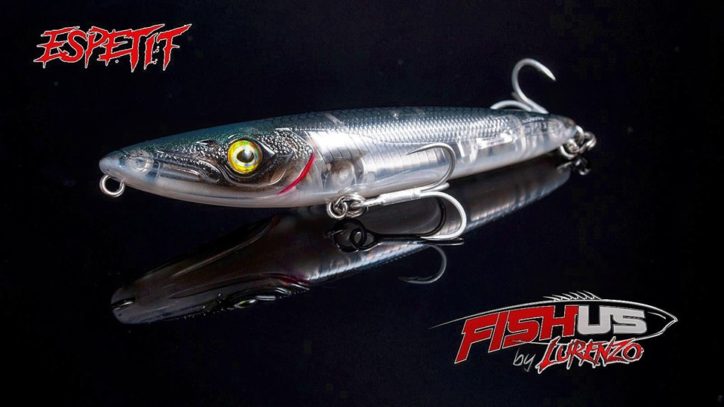
(“Espetit” lure. Photo © Lurenzo)
Now all my products are produced by Fishus, now I’m just the developer of the lures we produce together. Lurenzo Handmade doesn’t exist at the moment. I’m just starting a new project (Fishus by Lurenzo) and working hard on making new products I couldn’t do on my own, stay tuned!
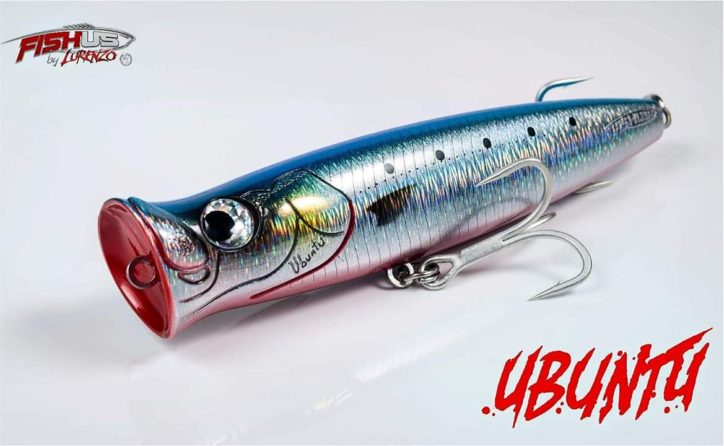
(“Ubuntu” popper. Photo © Lurenzo)
– What materials do you use to make your lures and for what reasons?
As for me, I began to make my lures from wood and various resins. In the early years I was focused on resins. But resins, like all materials, have pros and cons. Large and thin lures made of resins are not the best option in the mouth of some evil and strong predators. My first Belone and Espetrón had a short life, especially Don Belone, which was constantly killed in desperate battles with trophy bluefishes. Currently, a bluefin tuna, weighing more than 110 kilograms, is the largest fish caught with Belone. Italian fisherman Gianni Passaro won the battle against this fish. So, now it’s safe to say that the “right” materials are used to produce the lures.
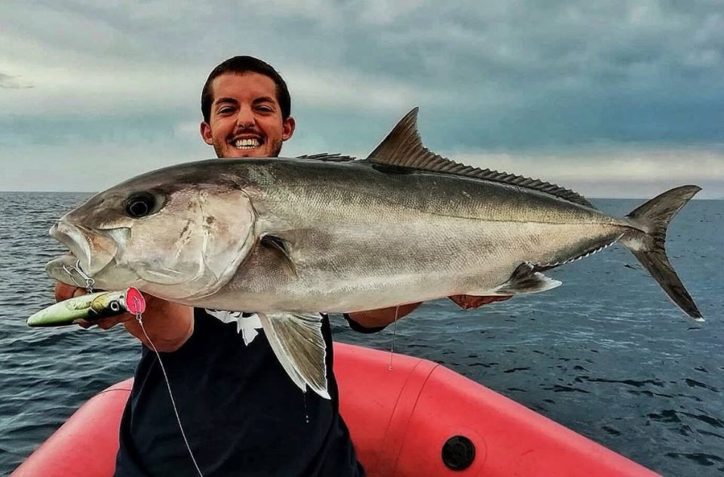
(Amberjack caught with “Ubuntu”. Photo © Lurenzo)
– adriaticnature often asks the interviewees about the color of the lure. What is your opinion as regards this issue? Is it really important to have a few Don Belone, Espetrón and other plugs of different colors in the set? In what situations and when did the change of color help you out?
The lures painted white are my personal favorite. I like to use lures with a yellow “back” for fishing in muddy water, and I prefer pink hues in cloudy weather in clear water with currents. When I use natural colors, I try to choose the ones that correspond to the food base of predators in this place and at this time – mullets, barracudas, bluefishes, mackerels, horse mackerels, pilchards and so on. And, of course, a lot depends on the color of the water, whether it looks greenish, bluish or whatever. All this stuff is personal preference.
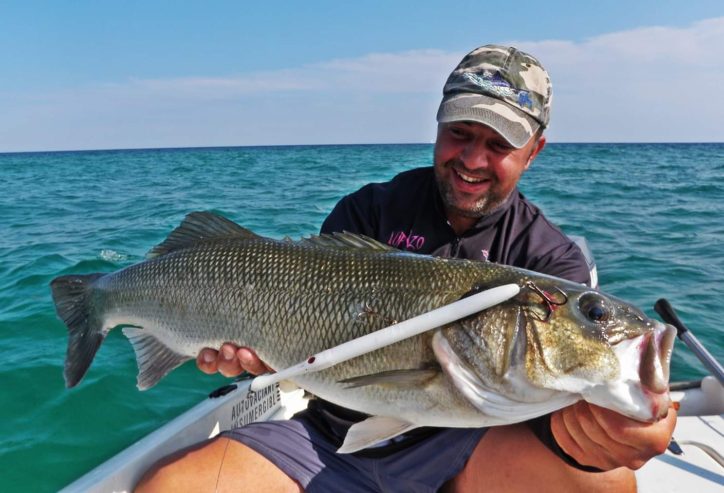
(European seabass caught with a white “Don Belone”. Photo © Lurenzo)
– What trophy and unusual fish were caught with your lures?
I can remember hundreds of excellent results. I will definitely never forget two of them: a swordfish caught from the shore in Barcelona with Don Belone, and a lot of huge dentexes, which were caught by my friend Sergio Nieto from the shore with Espetrón, it was so amazing!
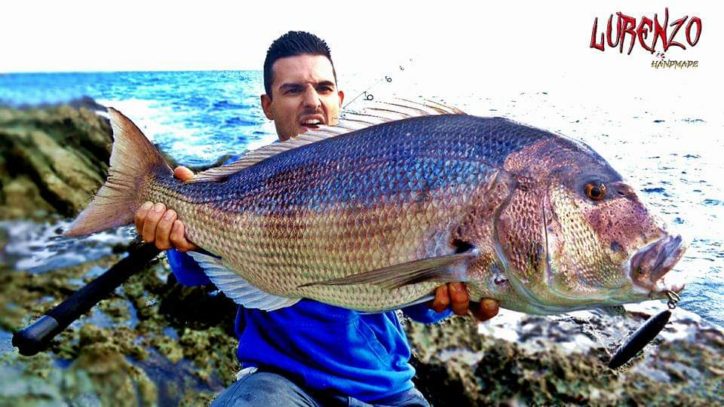
(Common dentex caught with “Espetrón”. Photo © Lurenzo)
– Do you have any suggestions and advice to the readers of adriaticnature?
The lures we were talking about were made with love and passion, they have great experience, they always dreamed of catching only trophy fish – the most precious treasure of a real angler. And I wish the readers of adriaticnature to always make their dreams come true!

(Peacock bass caught with “Espetrón”. Photo © Lurenzo)